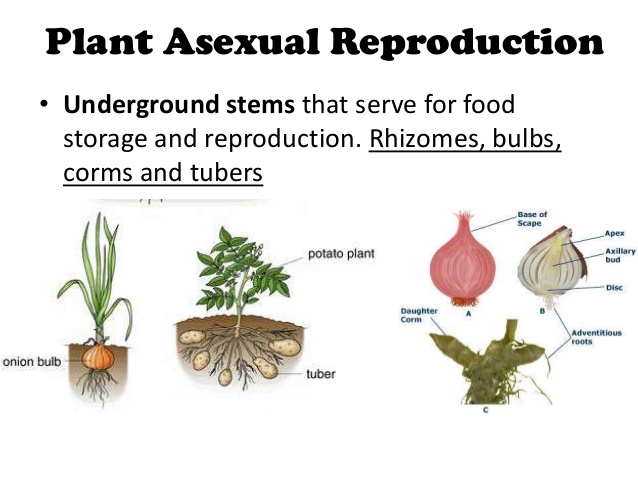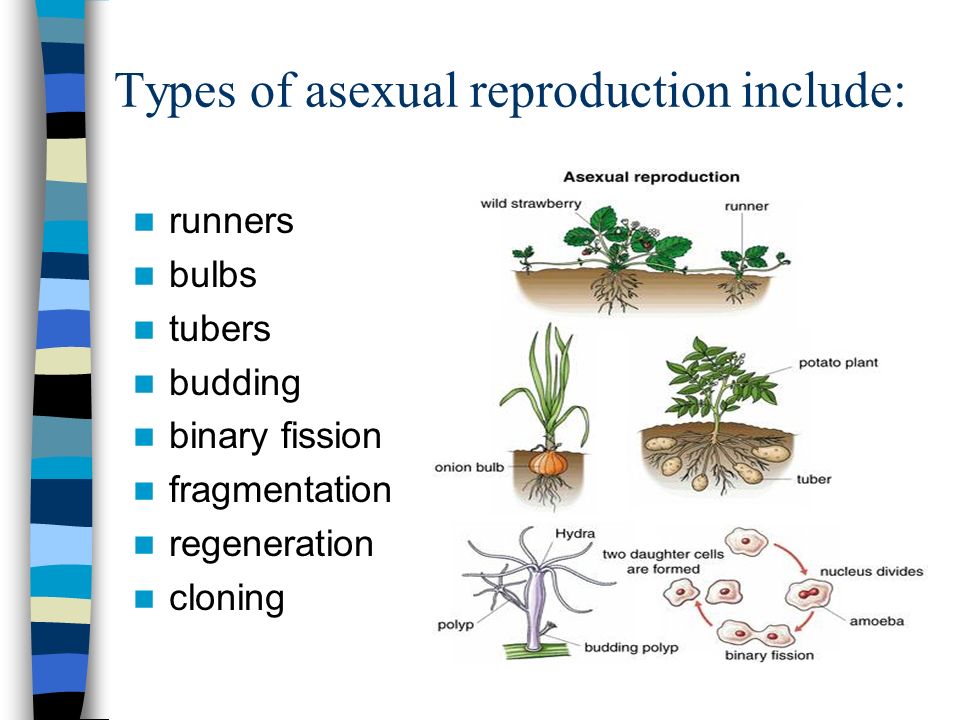Explain With Examples Different Methods of Asexual Reproduction in Plants
The corm is used by gladiolus and garlic. Since there is only one parent involved in asexual reproduction the offspring are genetically identical to the parent and to each other they are clones.

Advantages And Disadvantages Of Asexual Reproduction In Plants Science Online
This list of examples of asexual plants includes some pretty interesting plants including the dahlia.

. These are the different types of asexual reproduction of plants. Banana grape fig and chrysanthemum Check facts of the Animal Kingdom Types of Phylum their Characteristics here. Asexual reproduction through the multiplication of vegetative parts is the only method for the in vivo propagation of certain plants as they do not produce viable seeds.
Bulbs such as a scaly bulb in lilies and a tunicate bulb in daffodils are. Several root types stems and modified leaves carry out asexual reproduction and this can be seen in common plants around us. The first of all is to know what asexual reproduction in plants is.
There are different methods of asexual reproduction such as-. Various techniques are used to bring about vegetative propagation or plants asexual reproduction. Some of the plants which can be produced by asexual reproduction methods without seeds are.
Vegetative Propagation Several plants are capable of producing naturally through their roots stems and leaves. An alga reproduces by the asexual method of fragmentation. Many plants and fungi use spores as a means of asexual reproduction.
Examples Tuber of. Asexual reproduction produces plants that are genetically identical to the parent plant because no mixing of male and female gametes takes place. Its a ability of an organism to replace its lost body parts.
Hydra Spore formation -This is the most common method of asexual reproduction in majority of fungi and bacteria. Spirogyra reproduces by the asexual method of reproduction called fragmentation. Asexual or vegetative reproduction that occurs in certain animals plants and other organisms is constituted by the separation of cells or part of the body of a developed individual and through the process of mitosis another genetically identical organism can be producedThis type of reproduction can.
Fragmentation Adult organisms on maturation break up into smaller fragments. Many different types of roots exhibit vegetative reproduction. This plant is more than just a pretty flower it is also another asexual plant.
Plants such as ginger onion dahlia potato grow from the buds present on the surface of the stem. What is asexual and sexual reproduction. The image below shows the the process of Grafting.
Sexual Reproduction in Plants The production of new plants from existing plants by the fusion of their gametes or sex cells is called sexual reproduction. Plants Its a method of reproduction in plants. Each fragment develops into a new individual.
Plants use mainly three types of sexual reproduction and are as follows-. Step by Step answer for Explain with examples different methods of asexual of Biology Class 10th. Spirogyra is a green filamentous alga plant which is found in ponds lakes and slow moving streams.
Rose potato ginger turmeric sweet potato Dahlia sugarcane Bryophyllum and cactus. These types of organisms undergo a life cycle called alternation of generations where they have different parts of their lives in which they are mostly diploid or mostly haploid cells. The reproduction that involves only a single parent is called asexual reproduction.
The tunicate bulb is used in daffodils for asexual propagation. A stem tuber has several eyes on the surface. Natural methods of asexual reproduction include self-propagation.
Vegetative reproduction results in new plant individuals without the production of seeds or spores. Various methods of asexual reproduction Different methods of asexual reproduction are Vegetative propagation In this asexual reproduction new plants are produced from roots stems leaves and buds of the individual plant. Grafting requires that a part of the parent plant is cut and joined to another rooted plant so that they can grow as one plant.
Garlic gladiolus and crocuses Crocus use corm to reproduce asexually. The different ways in which a plant self propagates are mentioned below. An example of common alga is Spirogyra.
Many people think that the dahlia has a bulb but in fact it is a tuber. Asexual reproduction occurs mostly in unicellular organisms such as bacteria protozoa etc plants like fungi Bryophyllum and certain multicellular animals like amoeba and hydra. Along the surface of the soil thin and elongated stems form that will form spaced roots and that later will give rise to a new individual.
Science 16042020 0210 mahitej. Bulbs - underground food storage organs with fleshy leaves that store food and can grow and develop into. Asexual reproduction is the mode of reproduction in which genetic material is not exchanged and the offsprings are the exact copy of parent known as clones.
Bulbs scally bulbs are used in lilies for asexual reproduction. Three methods of plant asexual reproduction are. Plants have two main types of asexual reproduction.
Types of Asexual Propagation. Budding fragmentation vegetative propagation and spore formation are examples of Asexual Reproduction in plants. Vegetative reproduction and apomixis.
Such type of reproduction is called vegetative propagation. Explain with examples. Many plants are able to propagate themselves using asexual reproduction.
The plants produced by asexual reproduction tend to thrive well in stable environments. This method does not require the investment required to produce a flower attract pollinators or find a means of seed dispersal. No flowers are required for any of these methods.
Get FREE solutions to all questions from chapter LIFE. What is asexual and sexual reproduction. Budding- The process of in which bud is growing as a whole plant and is best observed in potato.

Asexual Reproduction In Plants Biology For Majors Ii

Types Of Asexual Reproduction Binary Fission Budding Regeneration Sporogony Parthenogenesis Tissues Culture Science Online


Comments
Post a Comment